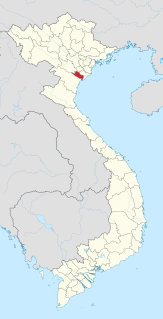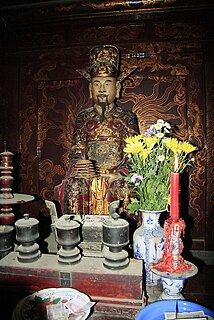"Tiến Quân Ca", also known as the "Army March" and the "Song of Advancing Soldiers", is the national anthem of Vietnam, both written and composed by Văn Cao in 1944. The "Marching Song" was adopted as the national anthem of Democratic Republic of (North) Vietnam in 1945, and was adopted as the national anthem of the new Socialist Republic of Vietnam in 1976, following the reunification of both North Vietnam and South Vietnam at the end of the Vietnam War. Though it has two verses, the first one is mainly sung.

Ninh Bình is a province of Vietnam, in the Red River Delta region of the northern part of the country. The province is famous for a high density of natural and cultural attractions, including reserved parks in Cúc Phương National Park and Van Long, grotto caves and rivers in Tràng An, Tam Cốc-Bích Động and Mua Caves, historic monuments in the Hoa Lư ancient capital, Vietnam's largest buddhist worshiping complex, and the Phát Diệm Cathedral with "eclectic architectural style". Thanks to its adjacency to Hanoi, day trips from the capital are easily manageable.

Hưng Yên is a province in the Red River Delta of northern Vietnam.

The Ngô Dynasty (939–965) was a dynasty in Vietnam.

South Central Coast is one of the regions of Vietnam. It consists of the independent municipality of Đà Nẵng and seven other provinces. The two southern provinces Ninh Thuận and Bình Thuận are sometimes seen as part of the Southeast region.The Paracel Islands, and Spratly Islands, are also part of this region.
Võ Tánh was an 18th-century Vietnamese military commander, best known for his role as a general of Nguyễn Ánh, who unified modern-day Vietnam and ruled as Emperor Gia Long.

National Route 1A is the trans-Vietnam highway. The route begins at km 0 at Huu Nghi Quan Border Gate near the China-Vietnam border. The route ends at at Năm Căn township in Cà Mau Province.

Hoàn Kiếm is an urban district (quận) of Hanoi, the capital city of Vietnam, named after the scenic Hoàn Kiếm Lake. The lake is in the heart of the district and serves as the focal point of the city's public life. The majority of tourist attractions in Hanoi are also located in the district.
Lieutenant General Lê Văn Kim is a former general of the Army of the Republic of Vietnam. He was the brother in law of General Trần Văn Đôn and together with General Dương Văn Minh, the trio organised the 1963 South Vietnamese coup which toppled President Ngô Đình Diệm and ended in the assassinations of Diệm and his brother, Ngô Đình Nhu.
Gò Quao is a rural district (huyện) of Kien Giang province in the Mekong River Delta region of Vietnam.
Kiều Công Tiễn or Kiểu Công Tiện was a general in the court of Dương Đình Nghệ, a Vietnamese Jiedushi of Tĩnh Hải quân who took over the position in 931. In 937 Kiều Công Tiễn assassinated the Jiedushi to seize his position and thus provoked a revolt led by Ngô Quyền who sought revenge his lord and father-in-law Dương Đình Nghệ. In response to the attack, Kiều Công Tiễn appealed to Liu Yan, the emperor of Southern Han, for reinforcements but he was defeated and executed by Ngô Quyền before the army of Southern Han entered the country. Later, Ngô Quyền had a decisive victory over the Southern Han in the Battle of Bạch Đằng River and marked the independence of Vietnam from Chinese authorities.
Khúc Hạo was the Vietnamese self-declared jiedushi of northern Vietnam from 907 to 917 succeeding his father Khúc Thừa Dụ.
Ná-Meo is a language of northern Vietnam, spoken by the Mieu people. Nguyen (2007) believes Na Meo may be a Hmongic language closest to Qiandong Miao.

Nam Từ Liêm is an urban district (quận) of Hanoi, the capital city of Vietnam. It was formed on 27 December 2013, when the rural Từ Liêm District was split into two urban districts: Bắc Từ Liêm and Nam Từ Liêm. Its population was 232,894 as of 2013.

Bắc Từ Liêm is an urban district (quận) of Hanoi, the capital city of Vietnam. It was formed on 27 December 2013, when the rural Từ Liêm District was split into two urban districts: Bắc Từ Liêm and Nam Từ Liêm. Its population was 320,414 as of 2013.

Đinh Liễn or Đinh Khuông Liễn (丁匡璉), was the eldest son of emperor Đinh Bộ Lĩnh, the founding emperor of Đinh dynasty.
Ngô Xương Văn was a ruler of Ngô dynasty, Vietnam. He was the second son of Ngô Quyền, the founder of Ngô dynasty.











